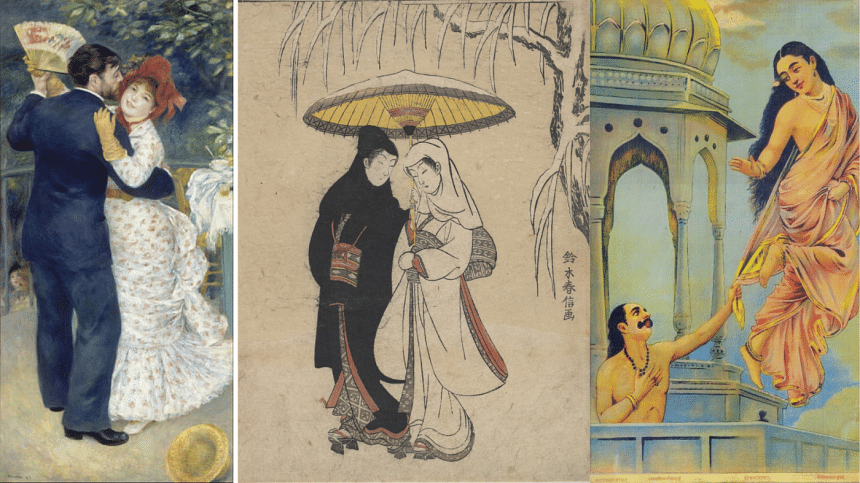Paintings on love and romance

One of the most prevalent themes in art throughout history is love. Paintings of lovers represent how views on love have changed over time and provide intriguing insights into how other cultures perceive love.
Love is illustrated as a charming and passionate emotion that transcends all constraints and resonates with everyone. From South Asia to Western societies, artists throughout the ages have given this emotion a bodily form in relation to their cultures, faith, and their personal experiences. These captivating representations show the myriad shapes and forms that love may take.
'Lovers in the Snow under an Umbrella' by Suzuki Harunobu (1767)
Suzuki Harunobu's woodblock print from the Edo era is both charming and depressing. The picture, which Harunobu created as a polychrome print, is a stunning example of his work and shows a couple strolling alongside one another through the snow. The calmness of the setting subtly exemplifies the Japanese style of 'wabi', the beauty of stillness and simplicity.
Harunobu highlights the closeness of two lovers wandering through the snow. The couple strikes the 'ai ai gasa' (love-love umbrella) position as they walk alongside one another in the softly falling snow, sharing an umbrella and thereby their admiration.
'Psyche Revived by Cupid's Kiss' by Antonio Canova (1793)
One of the most famous classical myths is the tale of Cupid and Psyche, which was a favourite subject for neoclassical artists. Venus, it is said, told Psyche not to open the flask she was to bring back from the Underworld. Psyche opens the flask out of sheer curiosity and the vapours put her into a coma-like sleep. The sculpture shows the scene right after Cupid had kissed Psyche to wake her up. The sculpture, which was made in 1793, is on exhibit in the Musée du Louvre in Paris.
'Danse à la campagne (Country Dance)' by Pierre Auguste Renoir (1883)
The woman in this oil canvas painting was modelled after Pierre Auguste Renoir's wife Aline Charigot. A disorganised table is visible behind the dancing pair and the man's hat appears to have fallen on the ground next to them. These subtle details give the sense that the couple is totally absorbed in their relationship and the music. The painting was created to go with another Pierre-Auguste Renoir painting, 'Danse à la ville (City Dance)', which highlights the lightheartedness of the country dancers even more by setting them against the more sombre city dancers.
'Unrequited Love: Urvashi and King Pururavas' by Raja Ravi Varma (1870)
Created by Raja Ravi Varma who is considered to be one of the greatest artists from India, this artwork is the perfect encapsulation of unrequited love. It depicts the one-sided love between a man and a woman. As the woman floats away, the man desperately tries to hold on to her. The facial expression of the man illustrates his love towards her as he looks up at the woman in admiration holding his right hand to his heart.
'Hopeful Love: Shakuntala' by Raja Ravi Varma (1870)
Shakuntala is another painting about love by Raja Ravi Verma. The character Shakuntala (the woman depicted in the painting) is from the Sanskrit epic, Mahabharata. She appears to stop on her path to remove a thorn from her foot. In reality, she is using this as an excuse to pause and look back at her lover.
She appears hopeful that he will pay attention to her. Maybe all she wants is to know what he is doing or simply to get a glimpse of him. In any case, we observe a woman who is completely preoccupied with her love for someone else. The smiles of her companions standing behind her seem to indicate that they are aware that she is feigning to pluck the thorn.
The way the observer is drawn into the scenario is one of the reasons this artwork is so well-known. Some viewers may recognise themselves in the way the women behave in the picture.
'Magical love: Bengal Fairy Tales' by Abanindranath Tagore (1920)
The founder of the Bengal School of Art and the Indian Society of Oriental Art, as well as a well-known painter and author, Abanindranath Tagore had a significant impact on the evolution of contemporary Indian painting.
In this well-known picture from 1920, two women are shown in a fantastical setting. Through some kind of enchantment, they seem to be amid the clouds and the moon. Their faces are peaceful and serene, and they are hugging each other tenderly. This well-known Indian painting portrays love as having a magical quality, one that makes you feel as though you are floating above the sky.
These paintings illustrate the purity and tranquillity of love, its playfulness, and embracing quality. Despite the personal and cultural association these paintings come with, they all speak of us as humans and resonate with the kind of love we all wish to experience.

 For all latest news, follow The Daily Star's Google News channel.
For all latest news, follow The Daily Star's Google News channel. 





Comments